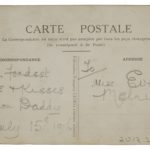Jack Melnick’s Postcard
- What can we see?
We can see pink and blue flowers sewn on the postcard. We can also see purple letters sewn above the flowers.
Look closely, what can you see?
- What do we know?
Jack Melnick sent this card to his daughter Eva in 1916, just two months before he was killed in the Battle of the Somme. The front of the card is embroidered and Jack added Eva’s name in pencil. The back of the post card reads, ‘With fondest love and kisses from Daddy.’ Eva would have been about four years old when she received this postcard.
Jack grew up in Hackney in the East End of London. He later married and had daughter Eva in 1912. In 1915, his wife died of Tuberculosis, so Jack and Eva moved in with his mother. They lived at 138 Jubilee Street, Commercial Road E1.
Jack trained in England and in France before becoming a rifleman in the 12th London Regiment. He was listed as wounded and missing on 9th September 1916.
The Battle of the Somme took place from 1st July 1916 to November 1916. It was one of the largest battles of the First World War. It took place in northwest France in the area surrounding the Somme River. The Battle of the Somme symbolises the horrors of war because of the high number of casualties. A casualty refers to both people that were killed and people that were wounded. By the end, the Allies and the Central Powers lost more than 1 million men making the Battle of the Somme one of the bloodiest battles in history.
- What might we wonder?
We might wonder how big this postcard is? We might also feel how Eva felt when she received this postcard?
What do you wonder?
- Object File
Object name: Postcard from Jack Melnick to his daughter Eva
Date: 15th July 1916
Catalogue number: JMM T2013.20.25
Material(s): Paper, Pencil, Embroidery thread
Before War broke out, the Post Office handled nearly 6 billion items of post each year. The Post Office was also responsible for Britain’s telegraph and telephone systems. The Army Postal Service (APS) was responsible for all army post between Britain and soldiers fighting all over the world. The Post Office also coordinated post between the different units on the front lines.
All pieces of post which were destined for troops overseas were sorted at the London Home Depot. The London Home Depot was a temporary wooden building covering five acres of Regent’s Park. The building was said to be the largest wooden structure in the world which housed over 2,500 mostly female employees. From 1914-1918 the Home Depot processed 2 billion letters and 114 million parcels.
Writing and receiving letters and postcards to loved ones was very important for soldiers’ morale. The British Army considered delivering letters to the front lines just as important as delivering rations and ammunition. Receiving letters and parcels from home was one of the few comforts a soldier had on the front lines. It was also a welcome distraction from the horrors of war. Picture postcards were very popular during the war for writing to loved ones and also collecting and trading. A photograph postcard would have been even more special as soldiers were often away for a long time. There were also agreements put in place between the Allies and the Axis Powers to ensure that post could also be delivered to and from prisoners of war.
The postal service was very efficient, but delays were caused by the censorship board and the war itself. All letters send home by the soldiers were subject to censorship. This was to ensure that secret information about the war effort did not fall into the wrong hands, and also to keep up morale on the Home Front.



